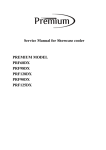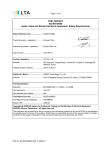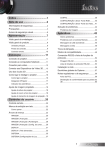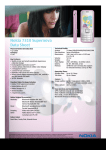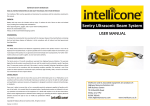Download TI21 Test Meter (TTM) Operating Instructions
Transcript
Battery type: Battery life: Automatic power down (battery saving) - after 30 minutes. Automatic backlight cancellation - after 30 seconds or at power down, whichever is shorter. Environmental conditions: Temperature range: Relative humidity: Ingress: 0°C to 40°C. 0% to 95% non condensing. IP54. Weight: Overall size: 0.46 kg. 190 mm x 100 mm x 70 mm. (Bombardier Part No. 6/6/117465GXL) SAFETY Observe all Safety Procedures that are in force for track possession, and for working on or near the track. High voltages may be present at track circuit rail connections. Work must be undertaken only by qualified & authorised personnel. If the TTM is past the calibration date specified on its calibration label, the TTM must not be used until it has been re-calibrated. Accessories: Soft carrying case Test leads Test clips Test probes. Approvals: TI21 Test Meter (TTM) Operating Instructions 4 x AA / LR6. Alkaline type recommended. Approximately 60 hours. EMC LVD ‘Safety style’ test leads must be used, i.e. test leads with a plastic shroud around the 4mm plug that connects to the meter. CE marked to EN 61326 CE marked to EN 61010. CAUTION Input terminals are not intended to be connected to voltages above 50V AC or 120V DC with respect to earth. ORDERING PARTICULARS Equipment Bombardier Part No. TTM including accessories 6/6/118365GXL TTM TTM case Test Leads with probes Test Clips Test Probes 6/6/117465GXL 118363 121899 118194 118195 Rocoil RCT 119044 INTRODUCTION Bombardier Transportation The TI21 Test Meter (TTM) has been designed to measure voltages at specific TI and ASTER/SF frequencies. It enables readings of track circuit parameters to be taken without corruption from other track circuits or interference at non-TI frequencies, e.g. 50/ 60Hz. It is intended for use as an aid to fault finding with TI and ASTER/SF track circuits. For normal setting-up procedures please refer to the appropriate Manual/Code of Practice/Handbook The TTM can also be used to measure track circuit current in the running rails when used in conjuction with a Rocoil Rail Current Transducer (RCT), please refer to the RCT operating instructions (note that an RCT is not supplied with the meter). The meter is supplied with a carrying case and leads. Estover Close Plymouth PL6 7PU England OPERATION Tel : +44 1752 725000 Fax : +44 1752 725001 M6/6/118951 Issue 3 : December 2001 (ecr 11246) © Bombardier Transportation (Signal) UK Ltd 2000 TTM is switched on when main switch is moved from OFF position to AC, DC or a frequency. Ensure that low battery indication is not displayed, if it is displayed replace the batteries. If unit powers down automatically after 30 minutes, it can be re-activated by pressing the backlight button or by operating the main switch. Track circuit frequency selection The frequency for operation for the track on which measurements must be set on main switch and an approximate voltage range must be selected on the range switch. AC or DC measurement If broadband AC or DC measurements are to be taken, the AC or DC position must be set on the main switch. The unit is fully isolated from rail-to-rail voltages and protected from overload of the input. Current measurement The TTM can be used to measure track circuit rail current in the running rails when a Rocoil rail current transducer probe is connected to the meter. This allows a profile of the rail current to be recorded to aid fault finding, particually for detecting where current leakage is occurring. Details of the RCT is given in the RCT operating instructions. Typical values for voltages across the rails at the transmitter tuning unit position can be found in the respective Manual/Code of Practice/Handbook and will indicate the state of the transmitter output. The receiver input current is measured by connecting the meter unit across the 1Ω resistor terminals. The meter reading then represents current, i.e. 0 to 20mV range represents 0 to 20mA. To check correct operation of the TI receiver, it is best to check its threshold by using a shunt box across the rails and monitoring the input current until the output relay drops. The value of current at which this occurs depends on the gain setting and manufacturing tolerances. Typical values of input current for various gain settings can be found in the TI Manual/Code of Practice. SPECIFICATION BATTERIES The batteries are located in a compartment at the rear or the meter. Access is achieved by releasing two screws and carefully lifting off the cover. Ensure that the batteries are fitted correctly and are of the leak proof type. Refit and secure the cover after fitting new batteries. A low battery indication appears in the display when the batteries need to be replaced. SIGNAL LEVELS OF “HEALTHY” AND “FAILED” TI EQUIPMENT Tables giving an indication of the typical minimum and maximum voltages or operating currents at different points in a track circuit can be found in the TI Manual/Code of Practice, or the ASTER Handbook. It must be emphasised that these can vary depending on the particular site conditions and weather, e.g. track ballast impedance. However, with the track circuits set up to operate with a 1.0 ohm shunt, this will ensure a minimum of a 0.5 ohm shunt under all conditions which may subsequently occur. Should the measured voltages differ considerably from the tables, a fault must be suspected. In particular, a check for a broken bond/rail should be made if the drop shunt rises significantly. It is recommended that when a track circuit is installed, a complete set of measurements are made and recorded, then any subsequent major deviations from these will indicate a condition which requires investigation. MEASUREMENT HINTS OFF AC Broadband 1699Hz - TI ‘A’ 2296Hz - TI ‘B’ 1996Hz - TI ‘C’ 2593Hz - TI ‘D’ 1548Hz - TI ‘E’ 2146Hz - TI ‘F’ 4.9 = 14:1 0.35 1848Hz - TI ‘G’ 2445Hz - TI ‘H’ DC OFF ASTER/SF ‘2600’Hz ASTER/SF ‘2300’Hz ASTER/SF ‘2000’Hz ASTER/SF ‘1700’Hz -3dB bandwidth on filtered ranges: 60Hz. Rejection on filtered ranges: >55dB at +-600Hz of centre frequency. -3dB bandwidth on AC Broadband range: 5Hz - 10kHz Input connections: 4 mm terminals suitable for shrouded plugs Accuracy: Display resolution: Over range display: ±10% of full scale. Input signal ranges (selected on Range switch): Maximum input voltage: Pole Zero Rejection Ratio This is the ratio of the track voltage measured at a “pole” tuning unit to the track voltage measured at a “zero” tuning unit. Example: If track voltage at “pole” is 4.9 V and at “zero” is 0.35V Rejection ratio = Main switch positions: 3 1/2 digits. + 0 to 20 mV 0 to 200 mV 0 to 2 V 0 to 20 V 0 to 200 V 250 V AC rms / 250 V DC (floating with respect to earth). CAUTION Input terminals are not intended to be connected to voltages above 50V AC or 120V DC with respect to earth. Track circuit frequency selection The frequency for operation for the track on which measurements must be set on main switch and an approximate voltage range must be selected on the range switch. AC or DC measurement If broadband AC or DC measurements are to be taken, the AC or DC position must be set on the main switch. The unit is fully isolated from rail-to-rail voltages and protected from overload of the input. Current measurement The TTM can be used to measure track circuit rail current in the running rails when a Rocoil rail current transducer probe is connected to the meter. This allows a profile of the rail current to be recorded to aid fault finding, particually for detecting where current leakage is occurring. Details of the RCT is given in the RCT operating instructions. Typical values for voltages across the rails at the transmitter tuning unit position can be found in the respective Manual/Code of Practice/Handbook and will indicate the state of the transmitter output. The receiver input current is measured by connecting the meter unit across the 1Ω resistor terminals. The meter reading then represents current, i.e. 0 to 20mV range represents 0 to 20mA. To check correct operation of the TI receiver, it is best to check its threshold by using a shunt box across the rails and monitoring the input current until the output relay drops. The value of current at which this occurs depends on the gain setting and manufacturing tolerances. Typical values of input current for various gain settings can be found in the TI Manual/Code of Practice. SPECIFICATION BATTERIES The batteries are located in a compartment at the rear or the meter. Access is achieved by releasing two screws and carefully lifting off the cover. Ensure that the batteries are fitted correctly and are of the leak proof type. Refit and secure the cover after fitting new batteries. A low battery indication appears in the display when the batteries need to be replaced. SIGNAL LEVELS OF “HEALTHY” AND “FAILED” TI EQUIPMENT Tables giving an indication of the typical minimum and maximum voltages or operating currents at different points in a track circuit can be found in the TI Manual/Code of Practice, or the ASTER Handbook. It must be emphasised that these can vary depending on the particular site conditions and weather, e.g. track ballast impedance. However, with the track circuits set up to operate with a 1.0 ohm shunt, this will ensure a minimum of a 0.5 ohm shunt under all conditions which may subsequently occur. Should the measured voltages differ considerably from the tables, a fault must be suspected. In particular, a check for a broken bond/rail should be made if the drop shunt rises significantly. It is recommended that when a track circuit is installed, a complete set of measurements are made and recorded, then any subsequent major deviations from these will indicate a condition which requires investigation. MEASUREMENT HINTS OFF AC Broadband 1699Hz - TI ‘A’ 2296Hz - TI ‘B’ 1996Hz - TI ‘C’ 2593Hz - TI ‘D’ 1548Hz - TI ‘E’ 2146Hz - TI ‘F’ 4.9 = 14:1 0.35 1848Hz - TI ‘G’ 2445Hz - TI ‘H’ DC OFF ASTER/SF ‘2600’Hz ASTER/SF ‘2300’Hz ASTER/SF ‘2000’Hz ASTER/SF ‘1700’Hz -3dB bandwidth on filtered ranges: 60Hz. Rejection on filtered ranges: >55dB at +-600Hz of centre frequency. -3dB bandwidth on AC Broadband range: 5Hz - 10kHz Input connections: 4 mm terminals suitable for shrouded plugs Accuracy: Display resolution: Over range display: ±10% of full scale. Input signal ranges (selected on Range switch): Maximum input voltage: Pole Zero Rejection Ratio This is the ratio of the track voltage measured at a “pole” tuning unit to the track voltage measured at a “zero” tuning unit. Example: If track voltage at “pole” is 4.9 V and at “zero” is 0.35V Rejection ratio = Main switch positions: 3 1/2 digits. + 0 to 20 mV 0 to 200 mV 0 to 2 V 0 to 20 V 0 to 200 V 250 V AC rms / 250 V DC (floating with respect to earth). CAUTION Input terminals are not intended to be connected to voltages above 50V AC or 120V DC with respect to earth. Battery type: Battery life: Automatic power down (battery saving) - after 30 minutes. Automatic backlight cancellation - after 30 seconds or at power down, whichever is shorter. Environmental conditions: Temperature range: Relative humidity: Ingress: 0°C to 40°C. 0% to 95% non condensing. IP54. Weight: Overall size: 0.46 kg. 190 mm x 100 mm x 70 mm. (Bombardier Part No. 6/6/117465GXL) SAFETY Observe all Safety Procedures that are in force for track possession, and for working on or near the track. High voltages may be present at track circuit rail connections. Work must be undertaken only by qualified & authorised personnel. If the TTM is past the calibration date specified on its calibration label, the TTM must not be used until it has been re-calibrated. Accessories: Soft carrying case Test leads Test clips Test probes. Approvals: TI21 Test Meter (TTM) Operating Instructions 4 x AA / LR6. Alkaline type recommended. Approximately 60 hours. EMC LVD ‘Safety style’ test leads must be used, i.e. test leads with a plastic shroud around the 4mm plug that connects to the meter. CE marked to EN 61326 CE marked to EN 61010. CAUTION Input terminals are not intended to be connected to voltages above 50V AC or 120V DC with respect to earth. ORDERING PARTICULARS Equipment Bombardier Part No. TTM including accessories 6/6/118365GXL TTM TTM case Test Leads with probes Test Clips Test Probes 6/6/117465GXL 118363 121899 118194 118195 Rocoil RCT 119044 INTRODUCTION Bombardier Transportation The TI21 Test Meter (TTM) has been designed to measure voltages at specific TI and ASTER/SF frequencies. It enables readings of track circuit parameters to be taken without corruption from other track circuits or interference at non-TI frequencies, e.g. 50/ 60Hz. It is intended for use as an aid to fault finding with TI and ASTER/SF track circuits. For normal setting-up procedures please refer to the appropriate Manual/Code of Practice/Handbook The TTM can also be used to measure track circuit current in the running rails when used in conjuction with a Rocoil Rail Current Transducer (RCT), please refer to the RCT operating instructions (note that an RCT is not supplied with the meter). The meter is supplied with a carrying case and leads. Estover Close Plymouth PL6 7PU England OPERATION Tel : +44 1752 725000 Fax : +44 1752 725001 M6/6/118951 Issue 3 : December 2001 (ecr 11246) © Bombardier Transportation (Signal) UK Ltd 2000 TTM is switched on when main switch is moved from OFF position to AC, DC or a frequency. Ensure that low battery indication is not displayed, if it is displayed replace the batteries. If unit powers down automatically after 30 minutes, it can be re-activated by pressing the backlight button or by operating the main switch.




